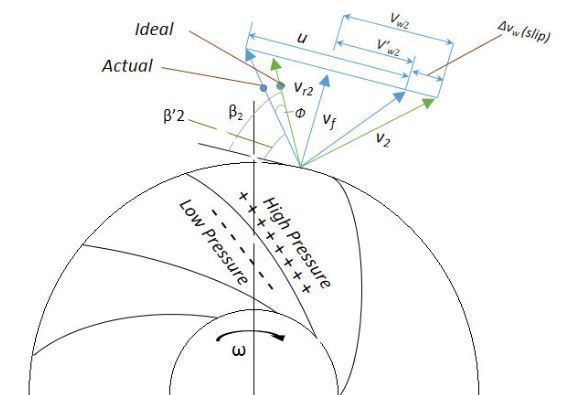 | ||
In turbomachinery, the slip factor is a measure of the fluid slip in the impeller of a compressor or a turbine, mostly a centrifugal machine. Fluid slip is the deviation in the angle at which the fluid leaves the impeller from the impeller's blade/vane angle. Being quite small in axial impellers(inlet and outlet flow in same direction), slip is a very important phenomenon in radial impellers and is useful in determining the accurate estimation of work input or the energy transfer between the impeller and the fluid, rise in pressure and the velocity triangles at the impeller exit.
Contents
- Factors accounting for slip factor
- Mathematical Formulae for Slip factor
- Slip Factor correlations
- References
A simple explanation for the fluid slip can be given as :Consider an impeller with z number of blades rotating at angular velocity ω. A difference in pressure and velocity during the course of clockwise flow through the impeller passage can be observed between the trailing and leading faces of the impeller blades. High pressure and low velocity is observed at the leading face of impellers blade as compared to lower pressure with high velocity at the trailing face of the blade. This results in a circulation in the direction of ω around the impeller blade which prevents the air from acquiring the whirl velocity equivalent to impeller speed with non-uniform velocity distribution at any radius.
This phenomenon reduces the output whirl velocity, which is a measure of the net power output from a turbine or a compressor. Hence, the slip factor accommodates for a slip loss which affects the net power developed which increases with increasing flow-rate.
Factors accounting for slip factor
- Mean blade loading.
- Thickness of blade.
- Finite number of blades.
Mathematical Formulae for Slip factor
Mathematically, Slip factor denoted by 'σ' is defined as the ratio of the actual & ideal values of the whirl velocity components at the exit of impeller. The ideal values can be calculated using analytical approach while the actual values should be observed experimentally.
where,
V'w2 : Actual Whirl Velocity Component ,Vw2 : Ideal Whirl Velocity ComponentUsually,σ varies from 0-1 with an average ranging from 0.8-0.9 .
The Slip Velocity is given as:
VS = Vw2 - V'w2 = Vw2(1-σ)
The Whirl Velocity is given as:
V'w2 = σ Vw2
Slip Factor correlations
The above explained models clearly states that the Slip factor is solely a function of geometry of Impeller. However, later studies proved that Slip factor depends on other factors as well namely 'mass flow rate',viscosity etc..
